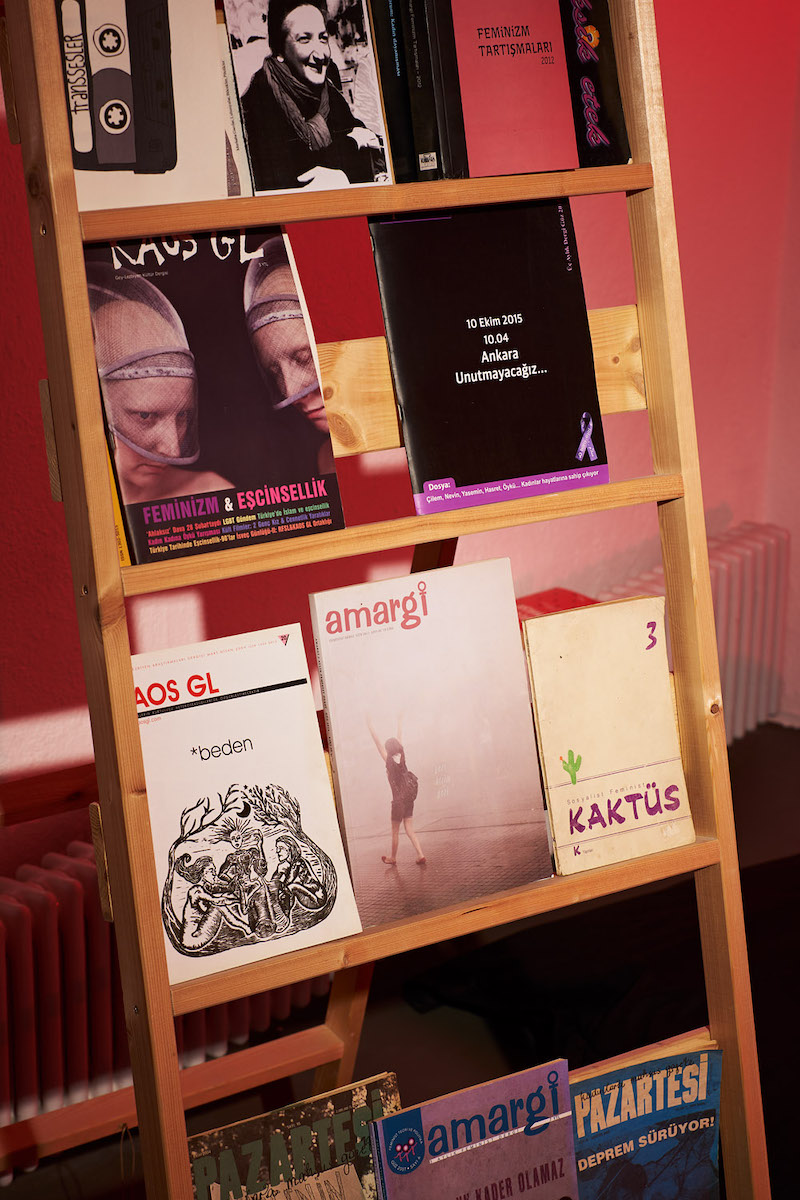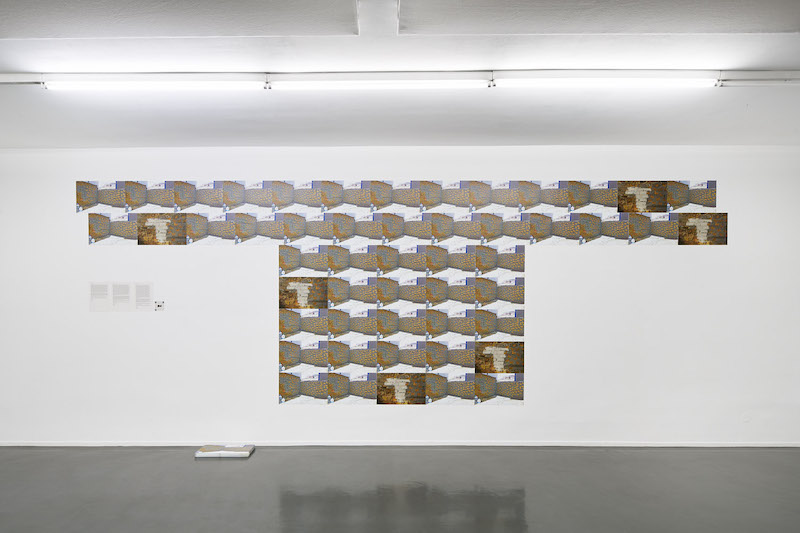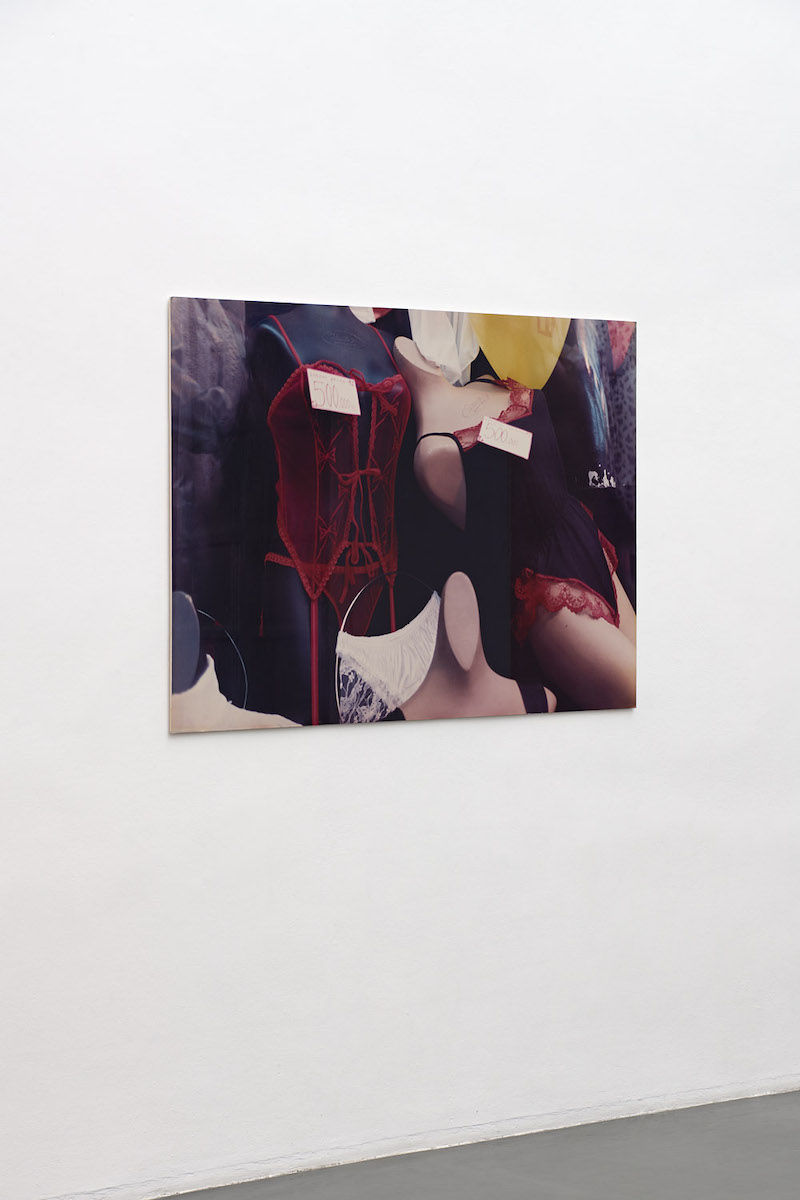
Installation View "unspeakable home, enchanting companions, Badischer Kunstverein, 2019 © the artists, Photo: Stephan Baumann
The Baden Art Association (Badischer Kunstverein) is currently hosting two expansive exhibitions synchronously focusing contemporary feminist art practices from Turkey; Nilbar Güreş’s solo exhibition "Lovers" and the group exhibition "unspeakable home, enchanting companions" curated by Derya Bayraktaroğlu. Collaborating with local artists, collectives, archives and publishing houses, and taking a satirical yet archival curatorial methodology, Derya Bayraktaroğlu focusses on bringing together current feminist and proto-queer discussions and practices from Turkey. In our interview, Bayraktaroğlu told me about the research period prior to the group exhibition, details about its public program and the difficulties of expressing up-to-date feminist discourses within and through art.
Mine Kaplangı: As curator of the show, how was the making and preparation process of "unspeakable home, enchanting companions" for you, Derya?
Derya Bayraktaroğlu: It was a dwelling for tracing links among the contemporary feminist movements' doings and art practice. Being neither research on political demands of the movement nor its configurations, the specific, that is, artistic quality of its doings is what I was interested in. It engages with a curiosity in the way queer feminist movement gazes back across neoliberal politics, socially fixed gender roles, homophobia and class struggle. Following up hybrid productions of queer feminism in Turkey was a kind of excavation for some reasons. Since the movement does not belong to a specific association, but can be found more in a flow, its traces are scattered to various social movements, organisations, initiatives or gathering places. Let alone those hubs that have been active and left discreetly, due to the recent lack of financial support, urban gentrification, and the oppressive political climate. And as the hubs disappear, so do their archives. I believe researching such a theme demands more fluidity; it needs not to be fixed, but rather accepted as incomplete and on the move. These were favourable challenges for me. The team of the Badischer Kunstverein, their efforts of understanding the nuances of a feminist struggle from another geography to mediate between different languages and cultures felt like expanding the kinship. Especially collaborating with the director of the Museum, Anja Casser, was a joy.
 Tümay Göktepe, Haunting high and low, 2015 © the artist, Photo: Stephan Baumann
Tümay Göktepe, Haunting high and low, 2015 © the artist, Photo: Stephan Baumann
MK: Was there a specific reason inspiring you curate "unspeakable home, enchanting companions"?
DB: Monique Wittig’s novel "Les Guérillères" from 1969, the way Wittig spreads the seeds for remembering and recalling '(her)story' and re-inventing it as a daily practice became an inspiration for me. It encouraged me to put forward a ‘story’ not as a past, but as rooted in companionship beyond generations and borders. More importantly, I was intrigued by the practices of all artists participating in the exhibition.


Gözde Ilkin, ID, 2011 Special Passport (Green Passport), 2009, COHESION (ADAPTATION) FUND, 2010 MustaKILL, 2011, TC, 2012 © the artist, Photo: Stephan Baumann
MK: What kind of works does the exhibition bring together?
DB: Nur Koçak’s “Ebrusan Shop Window Series”, which periodically captured the display preferences of a women's underwear shop in Istanbul, gives clues about social, cultural and political climates of the past. The video work ‘With Nil’ takes place in a train, in which the artist Melis Tezkan accompanies and interviews the pioneering artist Nil Yalter, whose thought-provoking oeuvre depicts the issues of women, working class, and excluded communities; immigrants and exiles. By featuring an erudite conversation grounded on the artists’ friendship, their shared thoughts on the notion of ‘displacement’, as well as their multiple experiences of living life as a woman, the work highlights a feminist critique of socially constructed notions of family, femininity and motherhood. Gökçe Yiğitel’s “Flying Trapeze” is a tribute to Valerie Solanas, recalling and appreciating the efforts of radical feminists and the artistic prodigies of those who were marginalized and excluded. Gözde İlkin’s practice shows a critical approach on the constitution of normative citizenship, while the photographic practice of Tümay Göktepe’s deals with normative femininity and womanhood. Both the work “Sweeping Walks” by Istanbul Queer Art Collective and the collectively produced wall graffiti; “A Public Monument; Golden Butterflies” by Leman Sevda Darıcıoğlu, Şevval Kılıç, and Derin Cankaya, tackle issues of urban gentrification and collective memory. The practice of Gülkan Noir involves a sharp critique of language as an everyday heteronormative construction, as Deniz Gül’s piece tackles with the relation of language and patriarchy. The work of the artist Ugemfo titled "No Money No Honey" utilises a traditional technique of embroidery to reclaim equality through the demands of trans- and LGBTI communities.

 Installation View, archival space "unspeakable home, enchanting companions, Badischer Kunstverein, 2019 Photo by Stephan Baumann
Installation View, archival space "unspeakable home, enchanting companions, Badischer Kunstverein, 2019 Photo by Stephan Baumann

 Installation View, archival space "unspeakable home, enchanting companions, Badischer Kunstverein, 2019 Photo by Stephan Baumann
Installation View, archival space "unspeakable home, enchanting companions, Badischer Kunstverein, 2019 Photo by Stephan Baumann
MK: The exhibition also incorporates an archival cellar space–– what do you think about the role of presenting archives and archival-based curatorial practices, given their urgency when it comes to feminist politics and feminist movements?
DB: What’s been recorded and fixed is ‘his’tory, whereas ‘story’ is more imaginary. I think dwelling on archives with a critical feminist perspective is needed for any field to circulate past for multiple and collective re-invention of stories. Despite that, I believe we need to problematise institutional governance of archives, its uniformity to be found in art institutions where curating takes place. What could queer politics or LGBTI audiences do with a cabinet in a Museum guarding the value of the clothes of a drag queen, who was once a legend? Or a hanging shelf of CD archives made thousands dance and march together? How could one build an affinity with a song without listening or reading it? We neither have art spaces, nor an institutional effort particularly pursuing feminist or gay heritage in Turkey. I think this lack becomes an advantage. It gives communities a chance to preserve their own stories and to communicate it directly with the public, which in return gives autonomy to the public, who may conserve as they please.
MK: What kind of archival materials can be discovered in this section of the exhibition? Are there any on-going feminist, queer and LGBTI archives that you are collaborating and focusing on deliberately from Turkey?
DB: Archival materials are mainly publications: books, magazines and zines together with the posters featuring organised festivals, conferences, workshops, happenings and demonstrations, solidarity parties and gatherings. Jointly they might provide an insight in the doings of feminist and queer activism in the recent era, as well as its influences and affections. A selection of 'Amargi' and 'Kaos GL Magazines' is included in the archive section of the exhibition. The 'Amargi Magazine' archive left behind 'Amargi Feminist Collective', which is quite important to keep track of feminist movements, while 'Kaos GL' (Kaos Gay and Lesbian Cultural Research and Solidarity Association), is still one of the remaining organisations in Turkey that have an indispensable interest in carrying out archival work for queer movements. Earlier feminist publications including 'Pazartesi’ and 'Kaktüs', and zines such as 'Transgender Güzeldir' and 'Kadınlar Arasında' can be found in the cellar, where you may sit or lie down to read. The posters feature the activities of autonomous initiatives such as 'Bağyan Feministival, İllet, Filmmor Women’s Cooperative' or 'Voltrans', together with the activities of the organizations including 'Lambdaistanbul Solidarity Association', 'Pink Life LGBTT' Association and much more. Besides, there is an on-going work carried out by recently blooming organisations such as 'The Social Policy, Gender Identity, and Sexual Orientation Studies Association SPoD', and 'Curious Steps: Gender and Memory Walks of Istanbul' by Sabancı University Gender Studies Department, who are developing an eligible environment for future researches.

Leman Sevda Darıcıoğlu (with Şevval Kılıç und Derin Çankaya) A Public monument, Golden Butterflies, 2014 © the artist, Photo: Stephan Baumann
DB: The public program performs the function of conveying a cultural essence of particular geography to reflect one of the many variations of feminist struggles in order to open up a dialogue. There is no certain itinerary of time considering the film program. There is the Yeşilçam Movie 'Asiye Nasıl Kurtulur' from 1986 and directed by Atıf Yılmaz, featuring the aspects of patriarchy in Turkish society. Although it is not compatible with queer and polyvocal thoughts with its vintage look, and full of drama at first glance, it discloses the roots of contemporary feminism in Turkey. Patriarchy still rules in the geography. It is still an issue for feminism to deal with. Even if there is no honour-killings or femicides in Europe, there is a supremacy to discuss together, so the struggle is equivalent. The program steps back to observe the request “tell me about your country” and it poses questions to finding common ground.
 Nur Koçak, Ebrusan Shop Window, 1995 © the artist, Photo: Stephan Baumann
Nur Koçak, Ebrusan Shop Window, 1995 © the artist, Photo: Stephan Baumann
 Nur Koçak, Ebrusan Shop Window, 1995 © the artist, Photo: Stephan Baumann
Nur Koçak, Ebrusan Shop Window, 1995 © the artist, Photo: Stephan Baumann
MK: How was the general reaction and attendance to the exhibition and its public program so far?
DB: The feedbacks of the audience at the opening and at the following events were quite pleasing.
I still remember a delicate discussion sparked spontaneously right after the screening of 'Asiye Nasıl Kurtulur' regarding ‘sex work’ to be considered as an empowered choice or patriarchal domination. There are genuine remarks from the community in Turkey as well. I think both exhibitions 'unspeakable home, enchanting companions' and 'Lovers' arouse interest back in town.
MK: Will you be focusing on the feminist and LGBTI archives and movements for your upcoming exhibition and programs?
DB: Not as a constant theme or concept, but as a path yes, I follow. I believe any subject or theme can be treated within the scope of feminist or queer criticism.
MK: Is there anything you plan as a secondary chapter of the exhibition?
DB: No plans, but I would like this exhibition to meet with audience in Istanbul. At home, it is more empowering for the community.


Installation View "unspeakable home, enchanting companions, Badischer Kunstverein, 2019 © the artists, Photo: Stephan Baumann
curated by Derya Bayraktaroğlu
Badischer Kunstverein
until June 23, 2019
With works by Nur Koçak, Nil Yalter & Melis Tezkan, Istanbul Queer Art Collective, Gökçe Yiğitel, Leman Sevda Darıcıoğlu (in collaboration with Şevval Kılıç and Derin Cankaya), Deniz Gül, Gülkan Noir, Gözde İlkin, Kanka Productions, Tümay Göktepe, Voltrans İnitiative, Aylime Aslı Demir and Ugemfo
